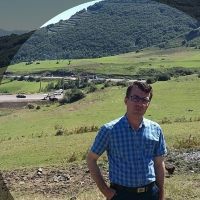Investigating the Effects of Geological Formations on the Runoff and Sediment Yield Using Rainfall Simulator in Gharehshiran Watershed, Ardabil
The comparison of different geological formations in term of sediment yield is one of the most important issues in many soil and water conservation studies. Moreover, the measurement of runoff production rate and sediment production is the prerequisite of watershed management. The potential of a watershed toward erosion is the result of erosivity, erodibility of geological formations, slope gradient and land use types in the watershed. Accordingly, runoff is one of the important factors in the water erosion issues. Different geological formations depending on the rock composition, erosion and slope gradient, have a potential to produce sediment and play an important role in the amount of soil losses. The behavior of rocks and quaternary deposits against weathering and erosion depend on the nature of the rock and environmental affecting factors. Therefore, the main aim of the present study was investigating and comparing the geological formations regarding the runoff and sediment yield along with runoff threshold in Gharehshiran watershed of Ardabil province using a rainfall simulator measurement.
Based on the geologic map of the studied area, the boundaries of different geological formations were defined and then according to the objectives of the present study, a field rainfall simulator (100 × 100 cm) with a height of one meter was used for field experiments. Theoretically, the use of rainfall simulator systems saves time and cost, which can be used for monitoring the amount of runoff and sediment along with all processes involved in erosion and sediment production. However, it should be noted that the use of rainfall simulators is also subject to limitations that can never fully create natural conditions. The plot scale measurements have been conducted through 45 samples in predefined geological formations of the studied area. The runoff threshold initiation time and the amount of runoff and sediment were recorded through field experiments. The runoff and sediment samples were collected in individually stored containers and were then, transferred to the laboratory. The values of runoff were measured and the samples were oven-dried for 24 hours at 105 °C and then the deposited amount of sediments were obtained. The amount of sediment in each sample was determined using a producer of precise weighting. Then, the normality of the data was analyzed using Kolmogorov-Smirnov test. The comparison of the geological formations was examined with respect to sediment amount, runoff, and initiation time threshold using One-way ANOVA method through SPSS software. Furthermore, the significant different in mean values of studied variables between geological formations were compared with Duncan's test. Then, the correlation between the studied variables in various geological formations was evaluated using Pearson correlation analysis in SPSS software.
The results of one-way ANOVA test showed that there was no significant differences between different geological formations considering runoff and sediment yield (p<0.05). While, there was a significant difference between geological formations with respect to the runoff threshold initiation time (p<0.05). Comparison of the mean values of runoff threshold time using Duncan test indicated that the highest and lowest thresholds time of runoff production were observed in Qt2 (alluvial terraces) and Qb (basaltic lava) formations with the values of 8.28 and 2.28 minute, respectively. According to the results, there was an inverse relationship between runoff and sediment variables in different formations. Also, the correlation between the runoff threshold time and the amount of runoff was negative with -0.318 correlation coefficient (p<0.05), while, correlation between the runoff threshold time and sediment yield values was positive (r=0.327) at 5% confidence level.
Many of the geological formations in this area were related to Quaternary and Tertiary periods. Young alluvial terraces and upland terraces, along with marl, sand, conglomerate, and clay formations were related to the Quaternary period, which were the results of erosion from rock units of past periods. It is suggested that the effects of other effective factors on erosion and sediment production processes should be considered in future researches to make a better and comprehensive conclusion. In conclusion, it can be said that studied geological formations were assigned to the Quaternary era and had a similar behavior in term of runoff and sediment production, while the difference in composition and mineralogy of different formations led to differences in runoff threshold.
- حق عضویت دریافتی صرف حمایت از نشریات عضو و نگهداری، تکمیل و توسعه مگیران میشود.
- پرداخت حق اشتراک و دانلود مقالات اجازه بازنشر آن در سایر رسانههای چاپی و دیجیتال را به کاربر نمیدهد.




